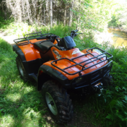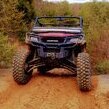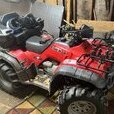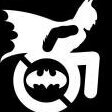-
Content Count
4,023 -
Joined
-
Last visited
-
Days Won
74
retro last won the day on June 25
retro had the most liked content!
Community Reputation
4,069 ExcellentPersonal Information
-
Location
Ojibwe Gichigami
4,411 profile views
-
retro started following 2005 350 Rancher ES, no spark, Facebook messenger, 2002 trx450fm and and 2 others
-

Rancher 350 4x4 OEM Front Disc Brakes Conversion
retro replied to retro's topic in Custom Builds - Restorations
Yeah there's no reward and nothing learned unless ya try. At the end of the day the only thing ever risked is money.... and that has less value than the potential to accomplish something useful. -
My bear hunting buddy just sold his 2000 TRX350TE for $3,000 on fakebook and bought a new '24 Rancher. 3k for a two-wheel drive Rancher 350 100% stock! That's crazy!!!! If I were you @shadetree I'd relist that primo 450 for $5k plus minimum! You'll get it!
-
Great! If ya need a pulse gen to try though, holler. I've been hoarding parts.
-

Rancher 350 4x4 OEM Front Disc Brakes Conversion
retro replied to retro's topic in Custom Builds - Restorations
That's all that needs to be done if your four knuckles have bad bearings in them. The '13 knuckles I got cheap from PSN had been underwater (with insufficient factory grease in them) and the bearings were junk, so I pressed out the bearings in the original 350 knuckles that I had removed, cleaned and repacked 5 years ago and cleaned and repacked them again. Same part number... and with almost 9,000 miles on them they are still like new. As for the extra work I did on the guards that decision was one one of those "I think it's possible so I'm gonna try" experiments. I didn't care if I screwed up and ruined the guards in the first attempts because replacements are only $11.66 each shipped at PSN. No matter what it takes the 420 disc brakes conversion is an awesome mod and worth every effort for sure! The only issue I found during this teardown was a bent steering stem shaft. I hadn't noticed anything wrong before now, so I'm guessing that I must have bent it in the woods climbing over dead trees or something.... maybe jammed a wheel hard between two logs when the Creamsicle landed? Dunno, but PSN is bailing me out on that fix too, cheaply. -

Rancher 350 4x4 OEM Front Disc Brakes Conversion
retro replied to retro's topic in Custom Builds - Restorations
The next steps for fitting both types of guards is mostly trial and error work. You'll need to use a heat gun to heat up two areas of the outboard ends of the 350 guards and bend the hot plastic into permanent shapes to provide clearance for the calipers when the handlebar is turned fully left or right, lock to lock. You'll also have to cut away a small portion off of the outer end of the 350 guard which adds clearance for the 420 guard and the caliper. I took a bit extra off of my 350 guard so that the calipers will have room to move inboard as the brake pads wear over time. You'll also need to cut and file on the lower mounting legs of the 420 guards so they'll clear the 350 guards as the handlebar is turned lock to lock, left and right. As I said there is no set pattern to getting it all clearanced right.... it's trial and error time consuming work, so take your time it's not 5:00 o'clock yet, right? Here is a photo of the right side completed. -

Rancher 350 4x4 OEM Front Disc Brakes Conversion
retro replied to retro's topic in Custom Builds - Restorations
Or if it's not yet 5:00 o'clock at your somewhere, or ya all outta cold ones....? Then you can have both the 350 and the 420 CV boot guards if you want to do a bit more work. Here is how I chose to accomplish that! Remove the brake hose fitting from the left side caliper because the first thing you'll have to do is use a round file to remove a bit of aluminum from the left side caliper brake hose stop. Put a nice lil' notch in there then follow up with a flat file so that the hose locator stop looks something like it looks like in this next photo. Bolt on both of your 420 outer CV boots guards and reattach the left side brake hose to the newly filed caliper. The notch you just filed into the caliper is necessary because the 420 CV guard won't bolt on until the brake hose attachment angle is correct. -

Rancher 350 4x4 OEM Front Disc Brakes Conversion
retro replied to retro's topic in Custom Builds - Restorations
After bolting the knuckles, tie rods, hubs & rotors and calipers on there is an issue with the fit of the brake hoses remaining. Because the caliper fittings of the 420 brake hoses differ from the 350 brake hoses ends, those 350 hoses don't bolt onto the calipers properly tucked in where we'd like them to. They sort of stick out actually once bolted to the calipers, the angles are all wrong.... looks kinda like a bad future could be in store for them. So I studied that predicament for a bit and I decided to try reversing them. I unscrewed the brake line from the Tee and unbolted the Tee from the frame and unbolted the brake hose brackets from both upper control arms. Then I pulled the four hose brackets off of the hose and flipped them over. Then flipped the hose over so that the right-side hose now goes to the left caliper and the left-side hose now goes to the right caliper. I removed the four plastic clips that held the drum brakes vent hoses to the brake hoses and unplugged that tiny vent hose Tee from the single vent hose (and plugged that open vent hose) that routes up to the Tee that vents the cooling fan motor. This is the 350 brake hoses after flipping the hold-down brackets over and flipping the hose over, left for right. The no longer needed drum brakes vent hoses and Tee, along with the four clips that routed those hoses alongside the brake hoses are shown in the center of the photo. And this is how that flipped brake hose looks when it is bolted back down. Much better looking hose angles at the calipers now.... ... and if you intend to leave off the 420 outer CV boot guards and instead cut the end of the 350 boot guard off to provide clearance with the disc brakes, then you are done with this conversion... bleed the air out of the lines and calipers with fresh DOT 4 syn fluid and grab some cold ones! -

Rancher 350 4x4 OEM Front Disc Brakes Conversion
retro replied to retro's topic in Custom Builds - Restorations
Now I want to talk about how I do the greasing of ball joints, tie rod ends and wheel bearings... and why I do it the way that I do. I pressed new OEM lower ball joints into each knuckle then I used a greaser to fill each boot with synthetic grease... the type of greaser you would use on a chain saw bar sprocket or other parts that receive lube through a tiny hole in the part. I pump the boots of every ball joint full, burping out all of the air that is trapped inside. I then remove both tie rods, use a small screwdriver to pry open the boots on each tie rod end and slide a needle greaser in alongside the screwdriver under the edge of the boots.... and pump those boots completely full of syn. When I refill the boots on the used parts during my yearly maintenance sessions I displace all of the old grease that I can, with new syn grease. As long as the boots are void of air and full of grease, water cannot ever get inside due to the hydraulic pressure effect the fully stretched boot exerts in the grease chamber when the part is bolted down tight. The way that I fill wheel bearings and the spaces around the bearings and seals with grease is similar, though I do it for an additional darn good reason. Grease packed inside a bearing will move out away from the bearing if there is excessive air space around it. Bearing life is shortened considerably when that happens.... because the bearing eventually runs dry and runs hotter than normal since there is no constant supply of clean grease moving through the bearing. Because the rotating action of the bearing naturally moves it's lubricant as it rotates, the lube ends up outside the bearing occupying the surrounding air space. When you tear down a corporately produced bearing that is precisely what you will find.... brand new, unused grease pushed out away from the bearing -- and nothing but air and blackened, saturated-with-metal-particles grease films clinging to the races of the bearing. While a bearing and the spaces surrounding it, when filled with grease properly, the bearing will "pump" or circulate all of the grease inside that space through the bearing during operation. The bearing then has a "reservoir" or extra volume of clean grease, all of the available grease will circulate continuously through the bearing keeping it wet and cold, providing bearing maximum life. Now when you tear down one of your properly packed bearings during a major maintenance session you'll find that all of the grease inside that filled space is the same color grey... grease has a soaping agent in it that greys as it cleans the bearing. For those two reasons given above, I pack them completely full, including the backs and lips of the seals, no air allowed inside! Here are the parts assembled and ready to install. I removed the wheel bearings from the original 350 drum brakes knuckles that I repacked 5 years ago and cleaned them in solvent, dried them with 91% alcohol, pressed them into the 420 knuckles and repacked them with syn again. Those wheel bearings have almost 9000 miles on them and they are still like new! -

Rancher 350 4x4 OEM Front Disc Brakes Conversion
retro replied to retro's topic in Custom Builds - Restorations
I've been asked what's the best way to reinstall the caliper pistons after replacing the seals, so I'll jump off a bit here to explain how I do it. The problem that must be overcome is the outer dust seal is impossible to stretch around the caliper piston without tearing up the seal unless there is an easy trick... and there is. Use compressed air, tighten the bleeder screw up, then use an air nozzle to blast air into the caliper bore through the hole where the brake hose bolts into the caliper. Your air nozzle must fit snugly against the hole so air doesn't leak past the nozzle too fast. Wrap the end of your nozzle with tape if yours is too small. Then clamp the caliper in a vise lightly. Don't crush it. Find a socket that fits inside the hollow piston and add a short extension that you can use for a handle. Control of the piston is the key here.... use a handle of some sort, don't try to use your fingers to hold the piston over the dust seal else they'll get crushed by the piston when you blast in the air. Wet down the caliper bore, the piston and both seals with clean DOT 4 synthetic brake fluid. Hold the piston firmly down against the dust seal like so: Give it a blast of air while holding the piston down firmly, centered over the dust seal best that ya can... the dust seal will expand and blow up like a balloon when ya blast the bore with air and the dust seal will pop over the end of the piston. If only half of the seal pops over the piston, press down again a bit while you move the piston away from the seal lip that is not yet started over the end of the piston and give it another blast. Practice makes perfect.... Once the dust seal is started over the end of the piston, rotate the piston with your fingers while pushing the piston down into it's bore. The piston must squeeze past the square-cut seal and rotating it while pressing it down will allow the piston to go in without risking damage to the square-cut seal. As the piston approaches the bottom of the bore the lip of the expanded dust seal will fall into it's square groove in the piston. Done! -

Rancher 350 4x4 OEM Front Disc Brakes Conversion
retro replied to retro's topic in Custom Builds - Restorations
I have been collecting parts for this upgrade for about 4 years and just never could find time to tear down my Creamsicle to do the work. But this summer marks the 5th season that I've been riding it since it's first major teardown and reassembly after I bought it, so I decided that another teardown for major maintenance tasks along with a few planned upgrades, should not be put off any longer. All of the spring maintenance has been done already, so this major teardown should only take about two more weeks to complete. The 420 Rancher disc brakes conversion is now completed.... and this thread outlines how I chose to do it. I tried to buy the parts as cheaply as I could: Powersportsnation.com supplied both the left and the right knuckles from a 2013 Rancher FE for $56 shipped. Great deal! Both left and right calipers plus the left and right rotor splash guards were found on eBay from a 2010 Rancher FM, also for $56 shipped. Smokin' deal! Both hubs and rotors were found on eBay from a 2007 Rancher FE for $62 shipped. Good parts, fair price. Brake pads sets for both sides were $39.90 shipped. Note that these are part number 06435-HP7-A01 which are the same fitting and quality as offered for the early 420s, but sell for 60% less than the early 420 brake pad part numbers. New OEM lower ball joints, OEM caliper seal kits, OEM inner and outer knuckles seals, 420 outer CV joint guards and a few new bolts were purchased from Rockymountainatvmc.com Here are those cheap parts stripped down, cleaned, rust treated and repainted. -
... using 2007-2013 Rancher 420 4x4 parts. All credits for this OEM disc brakes conversion belong to @jeepwm69! I thought that there is a thread outlining this upgrade but I cannot find it, so please point me to it if it exists and I will link to it in this post. This is a thread that mentions this bolt-in disc brakes conversion:
-

2006 Rancher ES Reverse & Neutral Lights are on, and will not start
retro replied to Diamondbar's topic in Electronics
It sounds like the gear position switch might be bad. The service manual explains how to test it using a multimeter. Also check the reverse switch located on the lower left rear of the motor. It has a single wire connector plugged into it.... make sure that it is plugged in. -
I'd check the frame ground next to the CDI and the ground on the right side rear area next to the clipped-to-the-frame harness connectors. Check fuses, and check for spark using the recoil to crank the motor over (rather than the starter motor) in case the solenoid flyback voltage protection diode (located in the fuse box) is bad. Check the Start/Stop switch on the handlebar, swap in a working ignition coil to rule that out, then check Peak voltages on the pulse generator and the coil. If you need a stator, a pulse gen, CDI, a coil or any other parts for testing, holler and I'll mail them to you.
-
@Norbert Denhof, I have removed the phone number you posted as this is a public forum. While you are logged in you can find your private messages box at: https://atvhonda.com/messenger/











